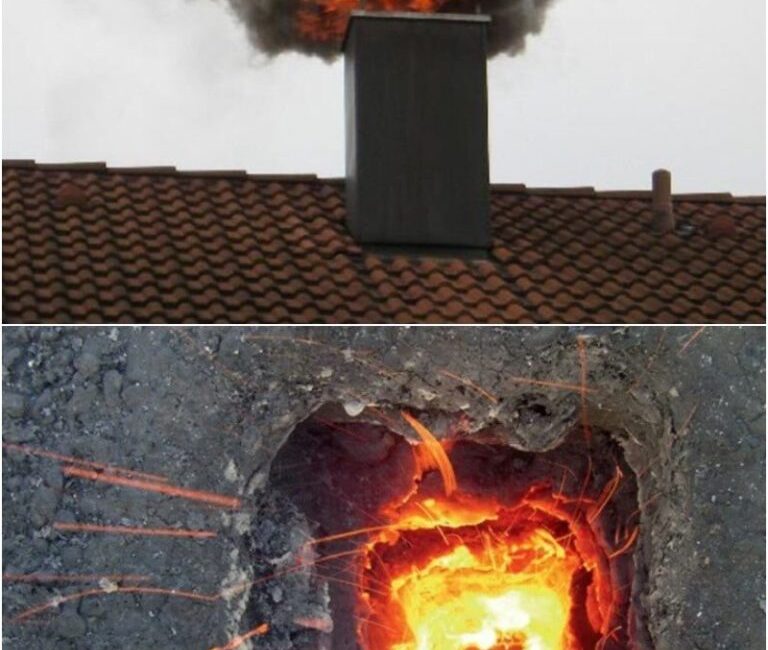In some cases, if the fire is small and you have the proper equipment, you may be able to extinguish the fire yourself. However, only attempt this if you are confident and safe. Never attempt to fight a large fire without professional help. Here’s how to approach it:
- Use a Chimney Fire Suppressant: If you have a chimney fire extinguisher (a special powder designed to suppress chimney fires), use it to help extinguish the fire. These products are often used by professionals, but they can be effective for homeowners as well.
- DO NOT use water: Never pour water into the fireplace or chimney. Water can cause steam explosions, especially when mixed with creosote, and it can also damage your chimney structure.
- Fireplace Tools: If you don’t have a fire extinguisher, avoid using traditional fire tools (like a shovel or broom) to try to suppress the fire. It’s best to let the professionals handle it.
6. Monitor the Fire Until Firefighters Arrive
Even if the fire seems to be contained and you’ve taken steps to reduce oxygen flow to the fire, stay outside the house and monitor the chimney from a safe distance. Wait for the fire department to arrive and confirm that the fire is fully extinguished.
- Keep watching for smoke, embers, or signs that the fire is still burning inside the chimney.
- Do not re-enter the house until the fire department has declared it safe.
7. After the Fire: Inspection and Repair
Once the fire department has cleared the area, there are several important steps to follow to ensure your home is safe from future chimney fires:
- Schedule a Professional Chimney Inspection: Even if the fire seemed small, it’s important to have your chimney thoroughly inspected by a certified chimney sweep. Chimney fires can cause internal damage that isn’t always visible, and the last thing you want is a repeat fire. They will:
- Inspect the chimney’s structure for cracks or weak spots.
- Clean out any remaining creosote buildup.
- Repair any damage that could affect the safety of future use.
- Repair Any Structural Damage: If the fire has damaged your chimney, roof, or nearby structure, it’s essential to have repairs done by a professional contractor. A damaged chimney is a fire hazard and can lead to further problems if not addressed.
Preventing Chimney Fires: Long-Term Safety Tips
While it’s crucial to know what to do during a chimney fire, prevention is the best defense. Here are some effective ways to keep your chimney and home safe:
- Get Your Chimney Cleaned Regularly
- Have your chimney professionally cleaned at least once a year or more often if you use your fireplace frequently. A certified chimney sweep will remove creosote buildup and other debris that can catch fire.
- Clean your chimney after each burning season to ensure it’s free of dangerous residues.
- Burn Only Dry, Well-Seasoned Wood
- Wet or green wood produces more smoke, which leads to more creosote buildup. Always use dry, seasoned wood to reduce the amount of soot and creosote produced during a fire.
- Install a Chimney Cap
- A chimney cap prevents debris (like leaves, twigs, and animals) from entering your chimney and causing blockages. It also helps prevent downdrafts and reduces the chances of a fire spreading to the roof.
- Burn Smaller, Hotter Fires
- A hot, clean-burning fire produces less creosote. Avoid slow-burning, smoky fires, and keep the fire burning hot to minimize soot buildup.
- Consider a Creosote-Busting Log
- These are special logs that, when burned, help reduce creosote buildup. While they are not a substitute for regular chimney cleaning, they can help keep the chimney cleaner between professional cleanings.
- Install a Carbon Monoxide Detector
- Chimney fires can lead to dangerous levels of carbon monoxide in your home. Ensure you have working carbon monoxide detectors on every level of your home, especially near sleeping areas.
Conclusion: Chimney Fire Safety
Soot fires in chimneys are a dangerous threat, but by following the right steps, you can minimize the damage and protect your home. Staying calm, calling 911 immediately, and evacuating your home are the most important first steps in handling the situation.
Once the fire is under control, don’t forget to schedule a professional chimney inspection and take preventative steps to ensure your chimney remains safe and clear of hazardous creosote buildup.
By maintaining your chimney and following safe burning practices, you can reduce the risk of chimney fires and enjoy the warmth of your fireplace without worry.
Stay safe, and remember: prevention is always better than dealing with the aftermath of a fire!




